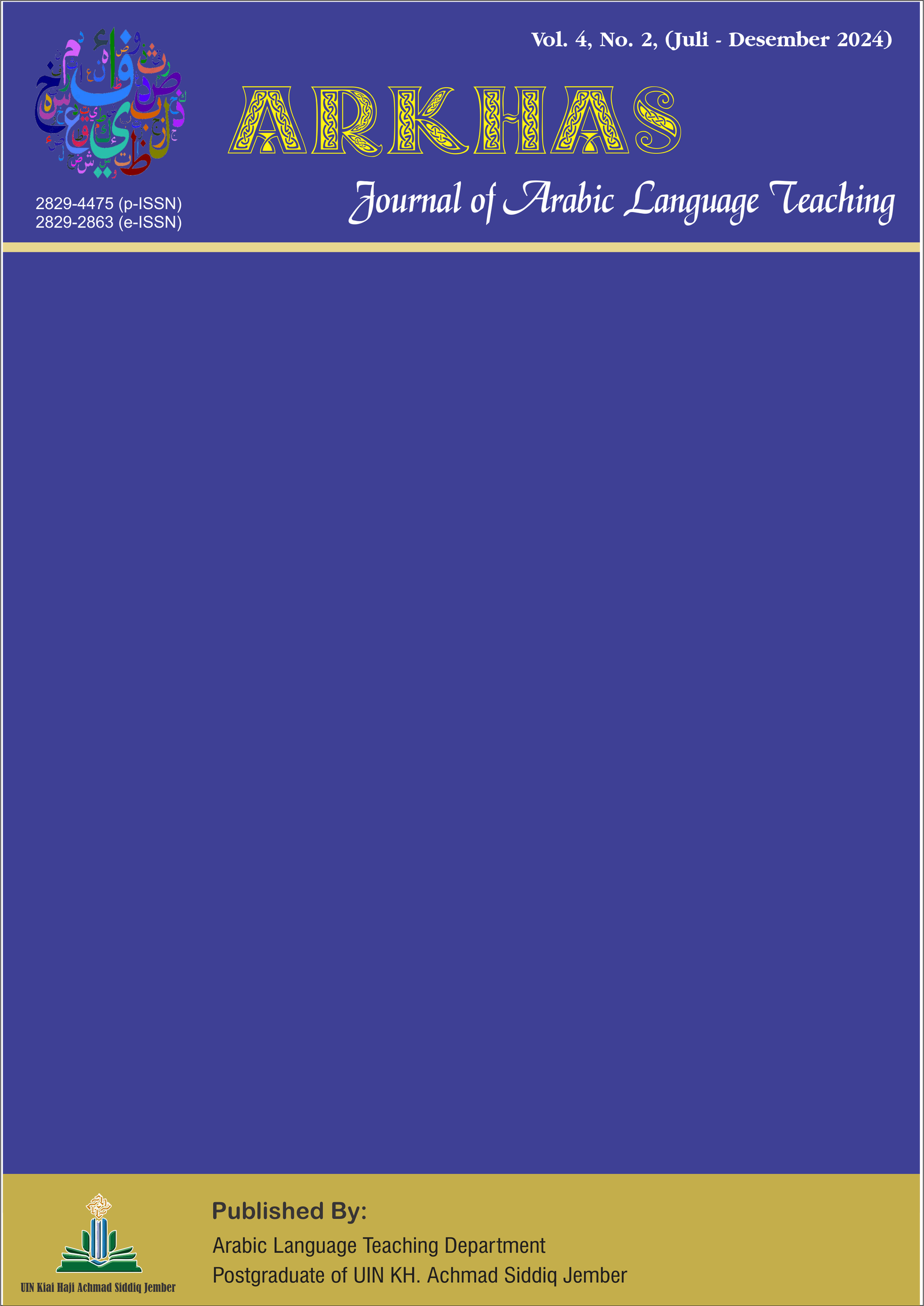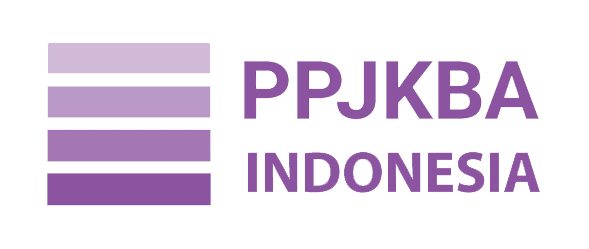تطوير وسيلة التعليم المبنية على البطاقات المصورة على مادة “البيت” لطلبة الصف السابع بالمدرسة الثانوية داتوك سليمان للبنين فالوفو
The Development of Picture Card-Based Teaching Media for the Lesson “Al-Bayt” (The House) among Seventh-Grade Students at Datok Sulaiman Boys’ Secondary School
DOI:
https://doi.org/10.35719/arkhas.v5i2.2343Keywords:
الوسيلة التعليمية, بطاقات المصورة, البيت, Arabic Learning Media, Picture Cards, Al-Bait, Dropping WordAbstract
This research aims to determine the development process, the validity level of the product, the practicality of the product, and the effectiveness of the developed product. This type of research is research and development (R&D), adapting the 4D development model, which consists of four stages: define, design, development, and disseminate. The subjects of this research were the seventh-grade students of Madrasah Tsanawiyah Datuk Sulaiman Palopo. Data collection techniques used were observation, interviews, validation sheets, student response questionnaires, documentation, and tests. Data were analyzed using quantitative data analysis techniques. The results of this development research showed that the comic learning media had passed the validation stages by experts with the following results: (1) validation from media experts obtained a score of 95%; (2) validation from subject matter experts obtained a score of 98.33%; (3) validation from practitioner experts reached a score of 95%, and the practicality trial resulted in an average score of 87.67%; (4) product feasibility/effectiveness test resulted in an average score of 86.56%. Based on the validation results from the three expert validators and the practicality test results, it can be concluded that the use of picture cards as a learning medium is feasible, fulfilling the criteria of being valid, practical, and effective, and thus can be applied in Arabic language learning.
يهدف هذا البحث إلى معرفة عملية التطوير ومستوى صلاحية المنتج ومستوى التطبيق العملي للمنتج ومستوى فعالية المنتج المطور. هذا النوع من البحث هو البحث والتطوير (R&D) من خلال تكييف نموذج التطوير رباعي الأبعاد الذي يتكون من أربع مراحل ، وهي التعريف والتصميم والتطوير والنشر. موضوع هذه الدراسة هو طالب الصف السابع في مدرسة تساناوية داتوك سليمان فالوفو. تستخدم تقنيات جمع البيانات الملاحظة والمقابلات وأوراق التحقق واستبيانات رد الطلاب والتوثيق والاختبارات. تم تحليل البيانات باستخدام تقنيات تحليل البيانات الكمية. تظهر نتائج هذه الدراسة التنموية أن وسيلة التعلم الهزلي قد مرت بمرحلة التحقق من الصحة من قبل الخبراء بالنتائج التالية: (1) تم التحقق من صحة خبراء التعليم للحصول على درجة 95٪. (2) حصل التحقق من صحة خبراء المادة على درجة 98.33٪ ؛ (3) وصلت الدقة من الممارسين الخبراء إلى 95٪ ، وحصلت نتائج اختبار التطبيق العملي على متوسط نسبة مئوية 87.67٪ ؛ (4) اختبار جدوى / فعالية المنتج بمتوسط درجة 86.56٪. بناء على نتائج التحقق من صحة المدققين الخبراء الثلاثة ونتائج اختبارات التطبيق العملي ، يمكن استنتاج أن استخدام البطاقات المصورة كوسيلة تعليمية ممكن مع استيفاء معايير صحيحة وعملية وفعالة بحيث يمكن تطبيقها في تعلم اللغة العربية.
References
Ahmad Wahyudi. (2024). Use of Picture Card Media to Improve Beginning Reading Skills of Elementary Students. Journal of Childhood Development, 4(1), 154–160. https://doi.org/10.25217/jcd.v4i1.3971
Al-Hamad, M. (2020). The qara’a: Defining a group in learning arabic as a foreign language. RomanoArabica, 20, 33–44. https://www.scopus.com/inward/record.uri?eid=2-s2.0-85111113152&partnerID=40&md5=f2f3305dba6a92550411e19e5db8ae02
Alho, K., Moisala, M., & Salmela-Aro, K. (2022). Effects of Media Multitasking and Video Gaming on Cognitive Functions and Their Neural Bases in Adolescents and Young Adults. European Psychologist, 27(2), 131–140. https://doi.org/10.1027/1016-9040/a000477
Aluwi, A. M., & Abdul Ghani, M. T. (2023). Penguasaan Kosa Kata Terhadap Penulisan Bahasa Arab dalam Kalangan Pelajar Sekolah Menengah Agama Khairiah: Kajian daripada Perspektif Guru. Sains Insani, 8(2), 294–303. https://doi.org/10.33102/sainsinsani.vol8no2.573
Annisa, A., Hasibuan, E., Dalimunthe, L. A. Z., & Nasution, S. (2025). Dampak Latar Belakang Pendidikan Pesantren Dan Non-Pesantren Terhadap Kemampuan Bahasa Arab Siswa Di MAS Muhammadiyah 01 Medan. Al-Muyassar: Journal of Arabic Education, 4(1), 37. https://doi.org/10.31000/al-muyassar.v4i1.12947
Ayatullah Muhaimin, & Grean Thoms. (2025). The Role of Visual Media in the Mastery of Arabic Vocabulary (Mufradat) for Grade VII Students of Salafiyah Wustho Islamic Centre Bin Baz Yogyakarta. International Journal of Post Axial: Futuristic Teaching and Learning, 73–84. https://doi.org/10.59944/postaxial.v3i2.440
Babayiğit, S., Roulstone, S., & Wren, Y. (2021). Linguistic comprehension and narrative skills predict reading ability: A 9-year longitudinal study. British Journal of Educational Psychology, 91(1), 148–168. https://doi.org/10.1111/bjep.12353
Bans-Akutey, A., & Tiimub, B. M. (2021). Triangulation in research. In Academia Letters. researchgate.net. https://www.researchgate.net/profile/Benjamin-Tiimub-2/publication/355425953_Triangulation_in_Research/links/616fd0f1b148a924b8013beb/Triangulation-in-Research.pdf
Beuckels, E., Ye, G., Hudders, L., & Cauberghe, V. (2021). Media Multitasking: A Bibliometric Approach and Literature Review. Frontiers in Psychology, 12. https://doi.org/10.3389/fpsyg.2021.623643
Chang, Y., & Thorson, E. (2023). Media multitasking, counterarguing, and brand attitude: Testing the mediation effects of advertising attention and cognitive load. Computers in Human Behavior, 139, 107544. https://doi.org/10.1016/j.chb.2022.107544
Dwiputra, Anis., Azis., & Haliq, A. (2017). Jurnal Pendidikan Bahasa dan Sastra. Analisis Kesalahan Berbahasa Pada Penulisan Media Luar Ruangan Di Kabupaten Bojonegoro, 17(April), 117–126.
Edwards, K. S., & Shin, M. (2017). Media multitasking and implicit learning. Attention, Perception, and Psychophysics, 79(5), 1535–1549. https://doi.org/10.3758/s13414-017-1319-4
Elsa Kaniawati, Meisya Edlina Mardani, Shania Nada Lestari, Ulan Nurmilah, & Usep Setiawan. (2023). EVALUASI MEDIA PEMBELAJARAN. Journal of Student Research, 1(2), 18–32. https://doi.org/10.55606/jsr.v1i2.954
Everhard Markiano Solissa, Rahayu Setyaningsih, Heppy Sapulete, Sumarni Rumfot, & Agus Rofi’i. (2023). Development of Flashcard Media in Improving Cultural Knowledge of Early Childhood Students. Journal of Childhood Development, 3(1), 71–78. https://doi.org/10.25217/jcd.v3i1.3373
Exposto, A. P. P. (2022). Development of Interactive Learning Media Using Adobe Flash Professional. In Kalam Cendekia: Jurnal Ilmiah Kependidikan (Vol. 10, Issue 2, p. 510). Universitas Sebelas Maret. https://doi.org/10.20961/jkc.v10i2.65781
Faiqoh, P. K., & Baity, A. N. (2024). Inovasi Pembelajaran Bahasa Arab dengan Buku Digital Silsilah Allisan untuk Penutur Non-Arab. In Al-Lahjah : Jurnal Pendidikan, Bahasa Arab, dan Kajian Linguistik Arab (Vol. 7, Issue 1, pp. 740–745). Universitas KH. A. Wahab Hasbullah. https://doi.org/10.32764/allahjah.v7i1.4329
Fitriyani, R., & Sari, E. F. (2024). Flashcard Development to Improve Learning Outcomes in Private 4th Class Science Learning. Jurnal Penelitian Pendidikan IPA, 10(10), 7259–7266. https://doi.org/10.29303/jppipa.v10i10.7372
Gading, I. K., Magta, M., & Pebrianti, F. (2019). PENGARUH METODE SUKU KATA DENGAN MEDIA KARTU KATA BERGAMBAR TERHADAP KEMAMPUAN MEMBACA PERMULAAN. Mimbar Ilmu, 24(3), 270. https://doi.org/10.23887/mi.v24i3.21417
Gleko Veronika, M., Timba Novenrius Sini, F., & Maria El Puang, D. (2023). Scholar: Media Educational Scientific Journal The use of picture card media on the reading ability of elementary school students. Scholar : Educational Scientific Journal Media, 13(4), 570–577.
Hasanah, M., Hasibuan, R., & Jundi, M. (2024). Elevating Arabic Vocabulary Learning: Integrating Teams Games Tournament and Show & Tell Method. Jurnal Pendidikan Bahasa Arab Dan Kebahasaaraban, 11(1), 31–45.
Heryanti, H. (2020). PENGGUNAAN MEDIA PEMBELAJARAN KARTU BERGAMBAR UNTUK MENINGKATKAN KEMAMPUAN SISWA MEMAHAMI MATERI MENGIDENTIFIKASI BENUA-BENUA PADA PEMBELAJARAN IPS DI KELAS VI SDN SUKADANAU 05 KABUPATEN BEKASI. Jurnal Pedagogiana, 8(4). https://doi.org/10.47601/AJP.18
Mahmudah, M. (2025). Enhancing Arabic Vocabulary with Hilyah Book. Al-Muhawaroh: Jurnal Pendidikan Bahasa Arab, 1(1), 1–11. https://doi.org/10.38073/almuhawaroh.v1i1.2427
Martello, M. B. (2017). The Use of Visual Arts in World Language Instruction to Increase Student Motivation and Attitude [Boise State University]. https://doi.org/10.18122/B27Q69
Maulidhah, D., Muhibbah, A. K., Ni’mah, F., Ummah, F. T., Maghfiroh, M., Fikriyyah, S., Ilmi, V. M., & Lathifah, E. (2023). Pengaruh Metode Pembelajaran Maharah Kalam Terhadap Pelajaran Bahasa Arab Pada Program Bimbingan Belajar. In Jurnal Ilmiah Dan Karya Mahasiswa (Vol. 2, Issue 1, pp. 167–178). Institut Teknologi dan Bisnis Semarang. https://doi.org/10.54066/jikma.v2i1.1380
Miles, M. B., & Huberman, A. M. (2014). Qualitative data analysis: A methods sourcebook (J. Saldana (ed.); 3rd ed.). SAGE Publication.
Mulyani, S., & Sholeh, A. (2023). Paradigma Pembelajaran Bahasa Arab (Analisis Kontrastif Metode Pembelajaran Konvensional dan Kontemporer). In Takuana: Jurnal Pendidikan, Sains, dan Humaniora (Vol. 2, Issue 1, pp. 63–75). MAN 4 Kota Pekanbaru. https://doi.org/10.56113/takuana.v2i1.71
Murphy, K., & Shin, M. (2022). Frequent media multitasking is not associated with better cognitive flexibility. Journal of Cognitive Psychology, 34(4), 516–528. https://doi.org/10.1080/20445911.2021.2002876
Niam, U. (2023). Development of Picture Card Media as a Geography Learning Media. Journal of Social Knowledge Education (JSKE), 4(2), 54–59. https://doi.org/10.37251/jske.v4i2.429
Oktaviani, P., & Isdaryanti, B. (2024). Learning Media for Sound Picture Cards Based on E-Flashcard Quizlet Content for Elementary School IPAS Lessons. Journal of Education Technology, 7(4), 742–751. https://doi.org/10.23887/jet.v7i4.69680
Panda, K. C., & Bartel, N. R. (1972). Teacher Perception of Exceptional Children. The Journal of Special Education, 6(3), 261–266. https://doi.org/10.1177/002246697200600308
Parawansa, K. I., Haryanto, S., & Mulyani, P. S. (2022). Penggunaan Media Flashcard Untuk Meningkatkan Kemampuan Membaca Siswa pada Mata Pelajaran Bahasa Indonesia Di Mi Klesman. Jurnal Informatika Dan Teknologi Pendidikan, 2(2), 72–78. https://doi.org/10.25008/jitp.v2i2.18
Pasaribu, M. M., Sormin, D., & Lubis, J. N. (2025). Efforts To Increase Students’ Learning Motivation Through Audio-Visual Media. Tafkir: Interdisciplinary Journal of Islamic Education, 6(3), 601–618. https://doi.org/10.31538/tijie.v6i3.1748
Rohman, A., Muhtamiroh, S., Imron, A., & Miyono, N. (2023). Integrating traditional-modern education in madrasa to promote competitive graduates in the globalization era. Cogent Education, 10(2). https://doi.org/10.1080/2331186X.2023.2268456
Sabri, M., Marwiah, M., & Saeful, M. (2023). Media Kartu Kata Bergambar untuk Meningkatkan Kemampuan Membaca Siswa Sekolah Dasar. JUDIKDAS: Jurnal Ilmu Pendidikan Dasar Indonesia, 2(4), 183–190. https://doi.org/10.51574/judikdas.v2i4.887
Saputra, D. (2023). The Influence of Interactive Learning Media Usage on Student Learning Motivation in Islamic Religious Education at Elementary Schools. Jurnal Ar Ro’is Mandalika (Armada), 3(1), 29–38. https://doi.org/10.59613/armada.v3i1.2842
Sari, F. A. H., Imron, A., Soesanti, S., & Kartikasari, F. (2024). Implementasi Discovery Learning Berbantuan Lembar Kerja Kartu untuk Meningkatkan Pemahaman Konsep Pembelajaran IPS Kelas VIII. Jurnal Pendidikan : Riset Dan Konseptual, 8(4), 664. https://doi.org/10.28926/riset_konseptual.v8i4.1077
Sciberras, M., & Dingli, A. (2023). Research Analysis—Triangulation Approach. Investigating AI Readiness in the Maltese …. https://books.google.com/books?hl=en&lr=&id=pyOqEAAAQBAJ&oi=fnd&pg=PA31&dq=triangulation+in+qualitative+research&ots=Y5-W9ZiEYg&sig=SLbk_Ezq6KQOccN7L2LpTGN0-Jo
Sri Rezeki. (2024). Penerapan Media Pembelajaran Audio Visual Dalam Pembelajaran Alkitab: Menggugah Minat dan Keterlibatan Siswa. Jurnal Riset Rumpun Agama Dan Filsafat, 3(1), 167–175. https://doi.org/10.55606/jurrafi.v3i1.2760
Strauber, C. B., Sorcar, P., Howlett, C., & Goldman, S. (2020). Using a picture-embedded method to support acquisition of sight words. Learning and Instruction, 65(August 2019), 101248. https://doi.org/10.1016/j.learninstruc.2019.101248
Syrovatko, Z., Yefremenko, V., & Mishchuk, D. (2023). Use of innovative approaches in physical education of students. Scientific Journal of National Pedagogical Dragomanov University. Series 15. Scientific and Pedagogical Problems of Physical Culture (Physical Culture and Sports), 3(162), 361–365. https://doi.org/10.31392/NPU-nc.series15.2023.3K(162).75
Uncapher, M. R., Lin, L., Rosen, L. D., Kirkorian, H. L., Baron, N. S., Bailey, K., Cantor, J., Strayer, D. L., Parsons, T. D., & Wagner, A. D. (2017). Media multitasking and cognitive, psychological, neural, and learning differences. Pediatrics, 140, S62–S66. https://doi.org/10.1542/peds.2016-1758D
Wibowo, L. Q. A., Iis Dahlia, Yeni Lailatul Wahidah, Agung Setiyawan, Umi Hijriyah, & Ahmad Arifin B. Sapar. (2024). Talking Stick Learning Model Assisted by Flashcard Media: Improving Mufradat Learning Outcomes. Izdihar : Journal of Arabic Language Teaching, Linguistics, and Literature, 7(1), 99–114. https://doi.org/10.22219/jiz.v7i1.31472
Xodabande, I., Iravi, Y., Mansouri, B., & Matinparsa, H. (2022). Teaching Academic Words With Digital Flashcards: Investigating the Effectiveness of Mobile-Assisted Vocabulary Learning for University Students. Frontiers in Psychology, 13. https://doi.org/10.3389/fpsyg.2022.893821
Yasmin Hussain, T. R. M. R. (2024). mproving Arabic Vocabulary among Form 2 Students at Temerloh Distric, Pahang using the “Snap Card” Game. 5(2), 167–186.
Zamanzadeh, N. N., & Rice, R. E. (2021). A Theory of Media Multitasking Intensity. Journal of Media Psychology, 33(4), 226–239. https://doi.org/10.1027/1864-1105/a000316
Zarrati, Z., Zohrabi, M., Abedini, H., & Xodabande, I. (2024). Learning academic vocabulary with digital flashcards: Comparing the outcomes from computers and smartphones. Social Sciences and Humanities Open, 9(March), 100900. https://doi.org/10.1016/j.ssaho.2024.100900
Downloads
Published
How to Cite
Issue
Section
License
Copyright (c) 2025 Nini Angriani, Mardi Takwim, Aishiyah Saputri Laswi

This work is licensed under a Creative Commons Attribution 4.0 International License.












